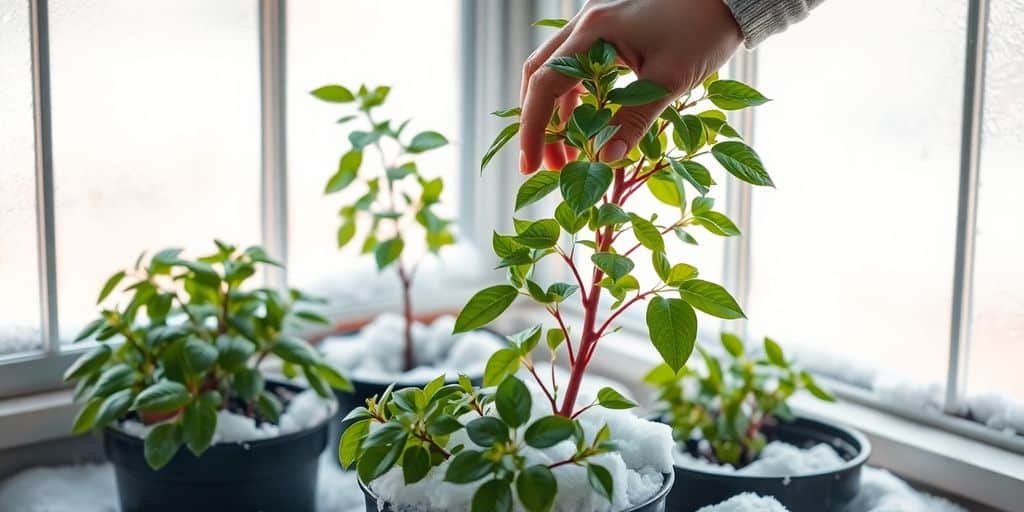How to adjust plant care for the winter season is essential for keeping your plants healthy during colder months. Winter brings unique challenges like lower light and cooler temperatures that require changes in care routines. Understanding these adjustments can help your greenery thrive despite the season.
Many plants slow down their growth in winter, needing less water and nutrients than usual. Knowing when and how to modify your watering and feeding habits is key to preventing overcare. With the right techniques, you can support your plants through this quieter phase.
In this article, we’ll share practical tips to help you master winter plant care. Whether you’re a seasoned gardener or a beginner, these insights will prepare you for successful plant maintenance all season long. Keep reading to learn how to protect your plants this winter.
Key takeaways
- Prune plants before winter to encourage healthy growth in spring.
- Use mulch to protect plant roots from freezing temperatures.
- Adjust watering schedules to avoid overwatering during dormancy.
Key seasonal plant care practices
Embrace the pruning ritual
Okay, so pruning can feel a bit intimidating, right? But trust me, it’s like giving your plants a haircut – it helps them grow stronger and healthier. Think of it as removing the dead weight so the good stuff can really flourish. I usually tackle this in late winter or early spring, before new growth really kicks in.
It’s all about snipping away any dead, damaged, or diseased branches. This not only improves the plant’s appearance but also encourages better air circulation and sunlight penetration. Plus, it can stimulate new growth, which is always a win!
Mulch: A winter blanket for plants
Mulch is seriously a game-changer, especially when winter rolls around. It’s like tucking your plants in with a cozy blanket. I’ve found that a good layer of mulch helps to insulate the soil, protecting the roots from freezing temperatures and those crazy temperature swings we sometimes get.
It also helps retain moisture, which is important even in winter, and suppresses weeds. I usually use organic mulches like wood chips or shredded bark, which break down over time and add nutrients to the soil. Just make sure to keep the mulch a few inches away from the plant’s stem to prevent rot. It’s a simple step that makes a huge difference!
Winter care strategies

Frost protection techniques
Okay, so frost can be a real pain, right? I’ve seen it totally mess up my neighbor’s hydrangeas more than once. Frost protection is super important, especially if you’re dealing with plants that aren’t exactly winter hardy. Here’s what I usually do:
- Covering: When a hard freeze is coming, I grab some burlap or even an old blanket and throw it over the plants. It’s not the prettiest look, but it works. Just make sure to remove it when the sun comes out so things don’t overheat.
- Mulching: Pile up some mulch around the base of your plants. It acts like a cozy blanket for the roots and helps keep the soil from freezing solid. I usually use pine straw because it’s what I have lying around, but shredded leaves work too.
- Location, location, location: If you know a cold snap is coming, move potted plants to a more sheltered spot, like against the house or in the garage. A little bit of protection can make a big difference.
Adjusting watering schedules
Watering in the winter is a whole different ballgame. Plants don’t need as much water when they’re dormant, so you gotta back off. I usually stick my finger in the soil to see if it’s dry before I even think about watering.
Overwatering can lead to root rot, and nobody wants that. It’s better to underwater a bit than to overdo it, in my experience. Plus, if it’s gonna freeze, you definitely don’t want soggy soil around the roots. That’s just asking for trouble.
Indoor winter care

Guidelines for Bringing Indoors
Okay, so winter’s knocking, right? Time to think about who’s coming inside. Not everyone can handle the cold, and some of my plants are total divas. First things first, you gotta figure out if bringing your green buddies inside is even necessary. Check the weather, see what kinda temps you’re dealing with. If it’s dipping way low, then yeah, indoor living is the way to go.
To make the move less of a shock, try this:
- Ease them in. Don’t just yank them from the cold into a warm room. Give ‘em a week or so to get used to it. A little time each day inside will do the trick.
- Pot smart. Make sure whatever they’re living in has good drainage. Soggy roots are a no-go.
Light and Temperature Requirements
Alright, they’re inside, but now what? Well, light and temperature are key. Think of it like setting up a comfy little plant spa. Most indoor plants need a good dose of light, but not necessarily direct sunlight. I usually aim for about 6-8 hours of indirect light. A south-facing window with a sheer curtain works wonders.
Temperature-wise, most houseplants are happy with what we’re happy with. I try to keep my place between 60°F and 70°F (15°C to 21°C). If you’re comfy, they’re probably comfy. Just keep them away from drafty windows or blasting heaters. That’s just asking for trouble.
Wrapping up your winter plant care
So, there you have it! Taking care of your plants during winter doesn’t have to be a headache. Just remember to keep an eye on watering, protect them from frost, and give them a little TLC with mulch and pruning. It’s all about adjusting your routine to fit the season.
With these simple tips, your garden can survive the cold and come back strong when spring rolls around. Don’t forget, winter is a time for your plants to rest, but with the right care, they’ll be ready to thrive when the warmer days return. Happy gardening!
Frequently asked questions
How should I prune my plants for winter?
Before winter arrives, trim any dead or overgrown branches. This helps your plants grow better in spring.
What type of mulch should I use?
Using organic mulch like straw or wood chips is great. It keeps the soil warm and moist for your plants.
How can I protect my plants from frost?
You can cover your plants with burlap or special frost cloth during cold nights to keep them safe.
